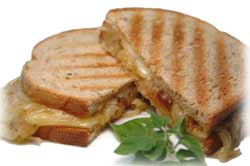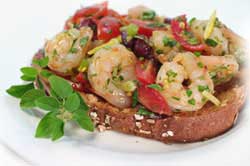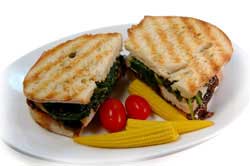Recipes for Fabulous Sandwiches
|
Reprinted with permission from 'wichcraft by
Tom Colicchio and Sisha Ortúzar, Text by Rhona Silverbush, Photographs
by Bill Bettencourt. Copyright 2009. Published by Clarkson
Potter/Publishers, an imprint of the Crown Publishing Group, a division
of Random House, Inc., New York, NY. Copyright 2009. All rights
reserved.
Gruyère with Caramelized Onions

You'll
never think of a "grilled cheese sandwich" in the same way again! The
piquant cheese choice of Gruyère paired with the sweetness of the
slowly cooked onions fashioned a sandwich where every bite was savored.
The extra sandwich we made at suppertime, reheated nicely for lunch the
next day doubling our enjoyment.
Click here to view the full recipe.
Click here for a printable version of the recipe.
.
Roasted Shrimp Salad with Tomatoes and Olives
The
authors described this shrimp salad (no mayo here!) as a shrimp scampi
sandwich. We couldn't agree more. The fresh vegetables and herbs
accentuated the garlicky shrimp. Heaped on toast that had been gently
rubbed with garlic, there was almost a panzanella aspect to this
recipe. The open-faced sandwich assembled easily for a
better-than-average lunch.
Click here to view the full recipe.
Click here for a printable version of the recipe.
Roasted Pork Loin with Prunes, Dandelion Greens, and Mustard
 This
sandwich proved to be a hearty supper meal with a perfect blend of
great complex tastes that were easy to recreate. The seared pork
tenderloin was complemented with the mustardy sweetness of the plums.
We substituted spinach for the dandelion greens and enjoyed the garlic
and vinegar flavorings of the greens with each bite of the sandwich.
The extra fixings made a great lunch the following day. This
sandwich proved to be a hearty supper meal with a perfect blend of
great complex tastes that were easy to recreate. The seared pork
tenderloin was complemented with the mustardy sweetness of the plums.
We substituted spinach for the dandelion greens and enjoyed the garlic
and vinegar flavorings of the greens with each bite of the sandwich.
The extra fixings made a great lunch the following day.
Click here to view the full recipe.
Click here for a printable version of the recipe.
|
Here's to better eating through better lunches!
|
|
Lorraine, Katie, and all of the Staff at Beyond Pots and Pans
|